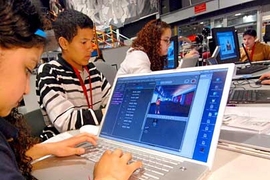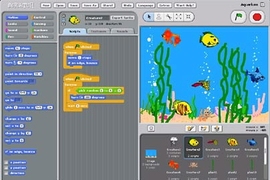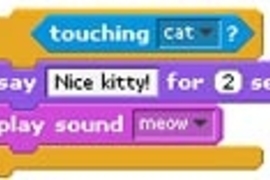A new programming language developed at the MIT Media Lab turns kids from media consumers into media producers, enabling them to create their own interactive stories, games, music, and animation for the Web.
With this new software, called Scratch, kids can program interactive creations by simply snapping together graphical blocks, much like LEGO® bricks, without any of the obscure punctuation and syntax of traditional programming languages. Children can then share their interactive stories and games on the Web, the same way they share videos on YouTube, engaging with other kids in an online community that provides inspiration and feedback.
"Until now, only expert programmers could make interactive creations for the Web. Scratch opens the gates for everyone," said Mitchel Resnick, Professor of Learning Research at the MIT Media Lab and head of the Scratch development team.
Resnick's Lifelong Kindergarten research group previously developed the "programmable bricks" that inspired the award-winning LEGO® MINDSTORMS® robotics kits. Just as MINDSTORMS allows kids to control LEGO creations in the physical world, Scratch allows them to control media-rich creations on the Web.
"As kids work on Scratch projects, they learn to think creatively and solve problems systematically -- skills that are critical to success in the 21st century," said Resnick.
Designed for ages 8 and up, Scratch is available by free download from the Scratch website (http://scratch.mit.edu). The software runs on both PCs and Macs. The MIT Media Lab is now collaborating with other organizations -- including Intel, Microsoft, Samsung, BT, the LEGO Group, Motorola, and One Laptop Per Child (OLPC) - to create other versions and applications of Scratch, including versions for mobile phones.
The name Scratch comes from the technique used by hip-hop disc jockeys, who spin vinyl records to mix music clips together in creative ways. Similarly, Scratch lets kids mix together a wide variety of media: graphics, photos, music, and sounds.
A glance at the Scratch website (http://scratch.mit.edu) reveals a kaleidoscope of projects created by kids: a story about a polar bear school, space attack games, and a break-dancing performance. Some creations are goofy and fun; some reveal serious social themes. Children are constantly modifying and extending one another's projects on the website - and learning from one another in the process. "It's exciting to wake up each morning and see what's new on the site," said Resnick.
Scratch was developed by the Lifelong Kindergarten research group in collaboration with UCLA educational researchers, with financial support from the National Science Foundation and the Intel Foundation. Throughout the development process, the design team received feedback from children and teens at Intel Computer Clubhouses and school classrooms.
"There is a buzz in the room when the kids get going on Scratch projects," said Karen Randall, a teacher at the Expo Elementary School in St. Paul, Minnesota. "Students set design goals for their projects and problem-solve to fix program bugs. They collaborate, cooperate, co-teach. They appreciate the power that Scratch gives them to create their own versions of games and animations."
For more information about Scratch, see http://scratch.mit.edu/about.
LEGO and MINDSTORMS are trademarks of the LEGO Group.
Used here with special permission. ©2007 The LEGO Group.
A version of this article appeared in MIT Tech Talk on May 16, 2007 (download PDF).











